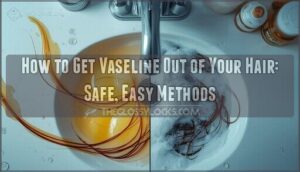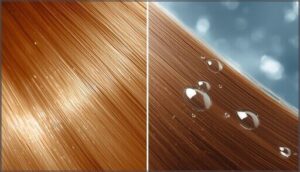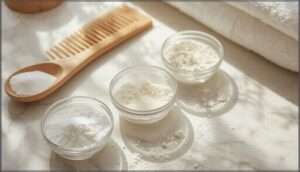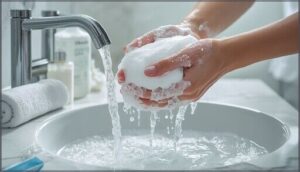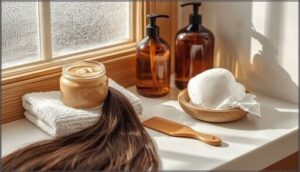This site is supported by our readers. We may earn a commission, at no cost to you, if you purchase through links.
Most people reach for Vaseline to protect their skin or lock in moisture, but when a generous blob lands in your hair, that same stubborn staying power becomes a nightmare. The petroleum jelly that won’t budge from your medicine cabinet shelf also won’t rinse away under a stream of water.
Its hydrocarbon chains form an occlusive barrier that clings to each strand, repelling water-based shampoos and trapping greasy buildup near your scalp. You can’t simply wash it out with your regular routine—you need strategic removal methods that break down the petroleum without stripping your hair or irritating your scalp.
The right approach depends on how much Vaseline you’re dealing with and your hair type, but several household items can cut through the grease effectively.
Table Of Contents
- Key Takeaways
- Why is Vaseline Hard to Remove From Hair?
- Can Vaseline Damage Your Hair?
- Preparing Hair for Vaseline Removal
- Step-by-Step Methods to Remove Vaseline
- Restoring Hair Health After Vaseline Removal
- Frequently Asked Questions (FAQs)
- How do you clean greasy hair with Vaseline?
- Does peanut butter remove Vaseline from hair?
- Is Vaseline bad for your hair?
- How do you remove Vaseline from hair?
- How to clean hair with Vaseline & oil?
- How to use Vaseline for hair loss?
- Does Vaseline cause permanent hair texture changes?
- Can heat tools help remove Vaseline faster?
- How long does complete removal typically take?
- Is Vaseline removal different for color-treated hair?
- Conclusion
Key Takeaways
- Vaseline’s hydrocarbon chains repel water and form an occlusive barrier on hair, making it impossible to remove with regular shampoo alone—you need oil-based solvents, absorbent powders, or degreasing agents to break down the petroleum coating effectively.
- The most effective removal methods include applying cornstarch or baking soda to absorb excess grease, using baby oil or coconut oil to dissolve the petroleum, and following up with dish soap or clarifying shampoo to cut through remaining buildup.
- While Vaseline won’t permanently damage your hair, heavy buildup can trap dirt, block moisture, clog follicles leading to scalp issues like folliculitis, and create a breeding ground for fungal growth if left too long.
- After removing Vaseline with harsh cleansers, you must restore moisture immediately with deep conditioning treatments and protein masks to prevent breakage, dryness, and cuticle damage from the stripping process.
Why is Vaseline Hard to Remove From Hair?
Vaseline sticks to your hair like glue because of its unique chemical makeup. Understanding why it’s so stubborn can help you avoid common removal mistakes.
Let’s break down what makes petroleum jelly so difficult to wash out and how it grabs onto each strand.
Chemical Properties of Vaseline
Fundamentally, Vaseline is petroleum jelly—a blend of hydrocarbons with high molecular weight that won’t dissolve in water. Here’s why it’s so stubborn:
- Hydrocarbon composition: The refining process creates chains of 25–30 carbon atoms that repel water completely
- Water repellency: It’s not water-soluble, so regular shampoo won’t cut it
- Melting point: It softens around 100–140°F but doesn’t rinse away
- Comedogenic barrier: Unlike oil-based soap or adhesive remover, it clings to hair stubbornly
Its color can range based on mineral base oils.
How Vaseline Interacts With Hair
When Vaseline lands on your hair, it forms an occlusive film over each strand’s cuticle—the overlapping scale layer that protects the fiber. This hydrophobic coating blocks water-based products and traps sebum near the scalp barrier, leading to visible buildup effects.
Despite claims, there are growth misconceptions: Vaseline doesn’t stimulate follicles or boost density. While it may moisturize a dry scalp, it won’t promote hair growth.
It’s not highly comedogenic, but heavy use near roots causes stubborn hair buildup.
Common Mistakes That Make Removal Harder
Knowing how Vaseline clings isn’t enough—you also need to dodge the traps that lock it in tighter. Hot water melts petrolatum, spreading it toward roots instead of lifting it away. Harsh cleansers strip natural oils, creating pores that trap Vaseline buildup in hair. Vigorous rubbing pushes residue deeper.
Incorrect layering—water before oil—forms a stubborn film. Inadequate rinsing leaves greasy patches, forcing you to start over.
Can Vaseline Damage Your Hair?
Vaseline won’t permanently harm your hair, but it can create problems if it builds up or sits too long. The thick coating blocks moisture and attracts dirt, which can lead to scalp issues and slow down healthy hair growth.
Here’s what you need to watch out for and how to use it safely.
Effects of Vaseline Buildup on Scalp and Hair
Think of your scalp like a breathing surface—when you layer on too much Vaseline, you create an occlusive barrier that traps everything underneath. This buildup changes your scalp microenvironment, blocking normal air flow and moisture balance.
Layering too much Vaseline on your scalp creates an occlusive barrier that traps moisture and blocks airflow underneath
The greasy film coats each fiber surface, leaving hair looking dull and weighed down. Plus, cleansing challenges multiply because regular shampoo can’t break through that stubborn hydrocarbon layer.
Potential Hair and Scalp Issues
Overuse can trigger folliculitis risk—those inflamed, itchy bumps around hair follicles that signal trapped oils. Scalp buildup creates a breeding ground for fungal growth, especially Malassezia yeasts linked to dandruff. You might also notice hair breakage when combing through stiffened strands.
Some research even connects high-tension styling with heavy products to alopecia link patterns, so understanding Vaseline side effects on hair matters for long-term scalp health.
How to Prevent Damage From Vaseline
To dodge Vaseline side effects on hair and prevent hair damage, limit the quantity to pencil-eraser-sized dabs on the ends only. Choose alternatives like jojoba oil for routine moisture. Use clarifying shampoos as cleansing strategies when buildup occurs.
Scalp protection means skipping root application entirely—the effects of Vaseline on hair worsen near follicles.
Preventing Vaseline buildup starts with fiber recovery conditioners after every strong wash to reverse hair damage.
Preparing Hair for Vaseline Removal
Before you start scrubbing away at Vaseline-coated hair, you need to set yourself up for success. Taking a few minutes to prepare can make the difference between an easy fix and a frustrating mess.
Here’s what you should do first to get your hair ready for removal.
Blotting and Absorbing Excess Vaseline
Before you try any removal method, you need to tackle surface grease first. Initial blotting with paper towels lifts excess Vaseline without pushing it deeper—avoid rubbing motions that spread the problem.
Next comes powder application: sprinkle cornstarch over affected areas and let it sit for 10–15 minutes. This timing sequence matters because hair’s absorbency works best when the powder has time to bind the grease before you rinse.
Choosing The Right Removal Method
Different hair types and Vaseline amounts call for different home remedies for hair. For heavy saturation, oil-based removal tops the list—baby oil dissolves petroleum better than any shampoo alone. When you’re dealing with small patches, cornstarch does the job faster. Your scalp sensitivity matters: dish soap cuts grease aggressively but can irritate, while clarifying shampoo balances method efficacy with gentleness.
Match your approach to:
- How much Vaseline coats your strands—thick buildup needs oils first
- Your hair’s texture—fine hair reacts differently than coarse
- Product availability at home—use what’s in your cabinet
- Time you can spend removing Vaseline from hair—quick fixes versus thorough treatments
- Past reactions to strong hair cleaning methods—watch for dryness or irritation
Safety and Precautions Before Starting
Before you tackle Vaseline in hair, protect yourself from scalp irritation and hair damage. Run a patch testing check with your chosen remover—dab a small amount behind your ear and wait fifteen minutes for redness.
Shield your eyes during application, keep harsh cleansers off sensitive scalp skin, and watch for signs of hair breakage. If burning or swelling appears, rinse immediately and seek professional help for severe reactions.
Step-by-Step Methods to Remove Vaseline
Now that your hair is prepped, it’s time to tackle the Vaseline itself. The right method depends on how much product you’re dealing with and what you have on hand.
Here are the most effective techniques to get your hair clean and back to normal.
Using Powders (Cornstarch, Baking Soda, Cornmeal)
Powders work like tiny sponges—they soak up grease without water. You’ll want to blot excess Vaseline first with paper towels, then sprinkle cornstarch, baking soda, or cornmeal powder generously onto the affected areas.
- Pat the powder in gently with your fingertips—don’t rub it
- Let it sit for 10-15 minutes so it can absorb the oil
- Brush or comb through carefully to remove the powder-Vaseline mixture
- Repeat if needed for stubborn buildup
- Follow with clarifying shampoo to finish the job
These household items for hair care are gentle and effective for initial treatment.
Oil-Based Removal (Baby Oil, Vegetable Oil)
When powders don’t fully cut through stubborn buildup, oil solubility steps in—fighting grease with grease. Baby oil, coconut oil, or olive oil break down Vaseline’s hydrocarbon chains better than water alone.
Here’s how to apply it:
| Oil Type | Application Techniques | Best For |
|---|---|---|
| Baby Oil | Saturate hair, massage 5-10 minutes | Quick, surface-level removal |
| Coconut Oil | Coat ends to roots, comb through | Deep penetration, protein protection |
| Olive Oil | Generous coverage, sit 10-15 minutes | Gentle, kitchen-accessible option |
Massage your chosen oil into Vaseline-coated sections until strands feel uniformly slick. Wrap hair in a shower cap for 15-20 minutes—warmth helps liquefy the mixture. These vegetable options and mineral oils prepare hair for cleanser protocols without harsh scrubbing.
Always follow safety precautions: patch-test new oils first, supervise children carefully to prevent slips, and avoid very hot water that could damage your cuticle.
Dish Soap or Clarifying Shampoo
After oil loosens Vaseline’s grip, you need real degreasing power. Dish soap cuts through petroleum jelly faster than regular shampoo—its surfactant types target grease like nothing else.
Wet your hair, lather thoroughly, and massage into Vaseline-coated areas. Rinse with warm water, repeating if needed. Yes, dish soap causes hair dryness, so deep-condition afterward.
Clarifying shampoo offers gentler scalp health protection while removing product buildup, though it costs more than the dish soap sitting under your sink.
Vinegar or Acidic Rinses
Vinegar won’t dissolve Vaseline—its hydrophobic chains laugh at acidic water—but apple cider vinegar rinses help after the heavy lifting’s done. Mix 2–4 tablespoons per cup of water, apply for 3–5 minutes, then rinse thoroughly.
- Rinse pH levels (2–3) tighten cuticles and loosen residual buildup
- Scalp normalization fights bacteria from prolonged occlusive use
- Application protocols: dilute 1:4, never exceed 10 minutes
- Safety concerns: undiluted vinegar causes chemical burns
- Buildup effectiveness: works on mineral deposits, not petroleum
Condition immediately—acid strips moisture fast.
Alternative Methods (Peanut Butter, Glycerin Soap)
When vinegar can’t finish the job, peanut butter lipids step in—massage creamy peanut butter into Vaseline-coated hair for 3–10 minutes, then comb through. Watch for allergen exposure risks.
For gentler cleansing, use a rich glycerin soap lather: repeat washing to lift residue after removal. Application best practices include sectioning hair and conditioning after, keeping strands smooth and manageable.
Restoring Hair Health After Vaseline Removal
After you’ve successfully removed the Vaseline, your hair needs some attention to bounce back. The removal process can strip away natural oils and leave your strands feeling dry or rough.
Here’s how to restore moisture and keep your hair healthy going forward.
Conditioning and Moisturizing Treatments
After stripping Vaseline with clarifying shampoo, your hair needs serious moisture and lipid replenishment. Start with a deep conditioning treatment for 10 to 20 minutes—protein treatments help patch cuticle damage while moisturizing formulas restore softness.
Follow up with a leave-in conditioner to lock in hair moisture and reduce dryness between washes. This combination prevents breakage and brings your strands back to life.
Tips for Preventing Future Buildup
Keep buildup away by swapping petroleum-based products for lighter formulations like argan or jojoba oil—they won’t trap residue. Adjust your shampoo frequency to two or three times weekly, adding clarifying shampoo once a week for scalp exfoliation.
If you live with hard water quality concerns, install a shower filter. Rotate your hair products regularly and follow a consistent hair care routine to avoid heavy accumulation and keep your strands fresh.
Frequently Asked Questions (FAQs)
How do you clean greasy hair with Vaseline?
Petroleum jelly contains hydrocarbons that resist water, so standard water temperature and rinsing techniques won’t cut through greasy buildup.
You’ll need clarifying shampoo application, absorbent powders, or oil-based product combinations to remove Vaseline effectively before gentle drying.
Does peanut butter remove Vaseline from hair?
Peanut butter can help dissolve Vaseline from hair because its high oil content breaks down grease. However, it leaves heavy residue and poses allergy risks.
Alternative oils like baby oil offer safer, equally effective grease removal.
Is Vaseline bad for your hair?
Think of Vaseline like a heavy blanket—it won’t break your hair, but it can suffocate your scalp.
Buildup effects, greasiness, and scalp safety concerns make it cosmetically tricky, not toxic.
How do you remove Vaseline from hair?
You can use absorbent powders like cornstarch, oil-based removal with baby oil, dish soap for degreasing, clarifying shampoo with multiple wash cycles, or vinegar rinses—checking for residue between applications.
How to clean hair with Vaseline & oil?
When Vaseline and oil coat your hair, start by gently detangling with a wide-tooth comb.
Apply clarifying shampoo to break down the greasy buildup, rinse thoroughly, then condition to restore moisture and softness.
How to use Vaseline for hair loss?
Most experts say Vaseline doesn’t promote hair growth. While it reduces breakage by coating strands, it can clog follicles and worsen scalp conditions.
For hair loss, use proven treatments like minoxidil instead of petroleum-based products.
Does Vaseline cause permanent hair texture changes?
No, Vaseline doesn’t cause permanent hair texture changes. This petroleum-based product coats hair strands without altering keratin restructuring or disulfide bonds.
Any temporary smoothing from buildup effects reverses once you remove the residue completely.
Can heat tools help remove Vaseline faster?
No, heat tools won’t help remove Vaseline and can cause hair damage. Melting vs. removal matters—heating spreads petroleum jelly deeper instead of lifting it, increasing product flammability risks and uneven heat distribution on coated strands.
How long does complete removal typically take?
Complete removal time varies widely based on how much Vaseline coats your hair. A light film may wash out in one 30–60 minute session, while heavy buildup often needs multiple washes over several days.
Is Vaseline removal different for color-treated hair?
Yes, dyed hair needs extra care. Color fade risk increases with clarifying shampoos, and oils are needed for product buildup effect removal.
Gentle cleansing is necessary, plus the importance of deep hydration helps prevent cuticle damage risk during hair treatment options.
Conclusion
Think of Vaseline removal like reversing a chemical bond—you need the right agent to break the seal. Whether you reach for cornstarch, dish soap, or baby oil, the key is patience and multiple rounds of treatment.
Now you know exactly how to get Vaseline out of your hair without damaging your strands or scalp. Your hair won’t stay greasy forever. With these methods, you’ll restore your natural texture and move forward smarter about petroleum-based products.
- https://www.wikihow.com/Get-Vaseline-out-of-Your-Hair
- https://www.clinikally.com/blogs/news/removing-vaseline-from-hair-without-harm-easy-non-damaging-techniques
- https://www.reddit.com/r/HaircareScience/comments/y3oc0t/baby_oil_is_a_cheaper_and_more_effective/
- https://www.peoplespharmacy.com/articles/getting-vaseline-out-of-hair-is-horrendous
- https://www.yalemedicine.org/news/beard-mustache-skin-problems

